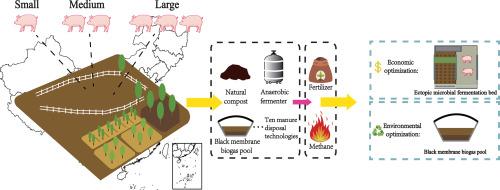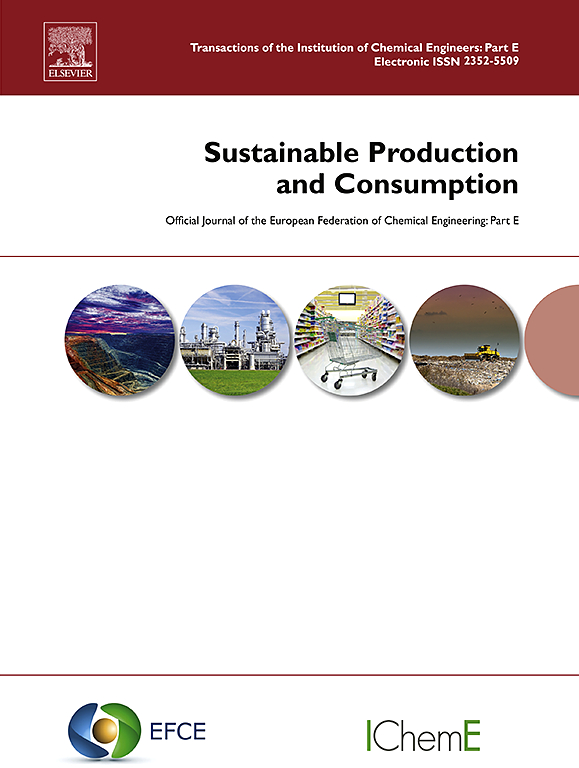Scaling sustainable pig manure treatment: Life cycle assessments for small to large piggeries in China
IF 10.9
1区 环境科学与生态学
Q1 ENVIRONMENTAL STUDIES
引用次数: 0
Abstract
Over 50 % of pig stockpiling and slaughtering in China is attributed to medium and large piggeries. The diverse scales and distributions of these piggeries present significant challenges for the sustainable management of pig manure, with a research gap in assessing the environmental benefits of treatment technologies across different farm sizes. Therefore, the environmental and economic performances of ten pig manure treatment technologies for small, medium and large piggeries were evaluated via life cycle assessment and life cycle costing methods. The black membrane biogas pool (BMBP) technology for medium-scale piggeries demonstrates superior environmental performance, reducing emissions by 44.00 kg CO2 equivalent, 0.36 kg SO2 equivalent, and 0.05 kg PM2.5 equivalent per ton of dry pig manure treated. Additionally, the products generated from this process can offset 2.93 GJ of energy consumption and 0.25 tons of water consumption. Meanwhile, the ectopic microbial fermentation bed technology provides the best economic efficiency, at the cost of only $17.88 per ton. Significant disparities in the scale of piggeries and manure production across provinces necessitate region-specific policies. The estimated global warming potential (GWP) from pig manure treatment nationwide was 5.31 million tons of CO2 equivalent, with Henan, Sichuan, and Hunan provinces accounting for a combined 28.3 % of this total in 2020. Scenario analysis indicates that by 2025, achieving a pig manure utilization rate of 90 % could reduce GWP by 9.1 % (0.5 million tons of CO2 equivalent) compared to an 80 % utilization rate, with reductions ranging from 1.78 % to 22.36 % across other environmental indicators. Promoting technologies such as BMBP and transitioning 5 % of aerobic processes to anaerobic processes could reduce emissions by 2.9 %, while also lowering other environmental indicators by 12.8 % to 20.1 %. The utilization of anaerobic technology, coupled with enhanced utilization rates, can prove more efficacious in mitigating carbon emissions and pollutants.

扩大可持续猪粪处理规模:中国从小型到大型养猪场的生命周期评估
在中国,50% 以上的生猪存栏和屠宰来自大中型猪场。这些猪场的规模和分布各不相同,给猪粪的可持续管理带来了巨大挑战,在评估不同规模猪场的处理技术的环境效益方面存在研究空白。因此,我们通过生命周期评估和生命周期成本计算方法,对小型、中型和大型养猪场的十种猪粪处理技术的环境和经济效益进行了评估。用于中型猪场的黑膜沼气池(BMBP)技术表现出卓越的环保性能,每处理一吨干猪粪可减少 44.00 千克二氧化碳当量、0.36 千克二氧化硫当量和 0.05 千克 PM2.5 当量的排放。此外,该工艺产生的产品可抵消 2.93 千兆焦的能耗和 0.25 吨的水耗。同时,异位微生物发酵床技术的经济效益最好,每吨成本仅为 17.88 美元。由于各省养猪场和粪便生产的规模存在巨大差异,因此有必要制定针对不同地区的政策。2020 年,全国猪粪处理产生的全球升温潜能值 (GWP) 估计为 531 万吨二氧化碳当量,其中河南、四川和湖南三省合计占 28.3%。情景分析表明,到 2025 年,猪粪利用率达到 90% 与利用率达到 80% 相比,全球升温潜能值可降低 9.1%(50 万吨二氧化碳当量),其他环境指标的降低幅度从 1.78% 到 22.36%不等。推广 BMBP 等技术并将 5% 的好氧工艺过渡到厌氧工艺可减少 2.9% 的排放量,同时还可将其他环境指标降低 12.8% 至 20.1%。事实证明,利用厌氧技术,再加上提高利用率,可以更有效地减少碳排放和污染物。
本文章由计算机程序翻译,如有差异,请以英文原文为准。
求助全文
约1分钟内获得全文
求助全文
来源期刊

Sustainable Production and Consumption
Environmental Science-Environmental Engineering
CiteScore
17.40
自引率
7.40%
发文量
389
审稿时长
13 days
期刊介绍:
Sustainable production and consumption refers to the production and utilization of goods and services in a way that benefits society, is economically viable, and has minimal environmental impact throughout its entire lifespan. Our journal is dedicated to publishing top-notch interdisciplinary research and practical studies in this emerging field. We take a distinctive approach by examining the interplay between technology, consumption patterns, and policy to identify sustainable solutions for both production and consumption systems.
 求助内容:
求助内容: 应助结果提醒方式:
应助结果提醒方式:


